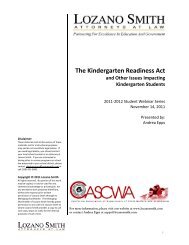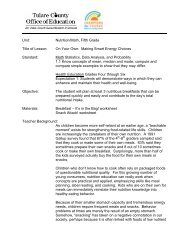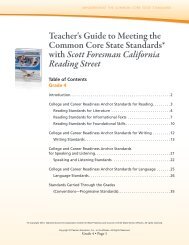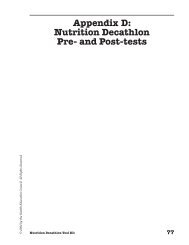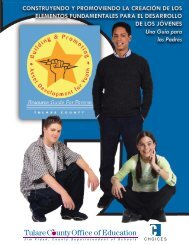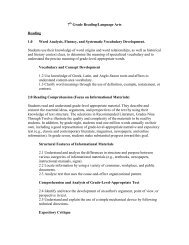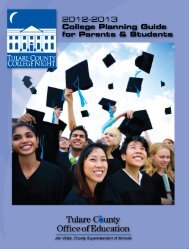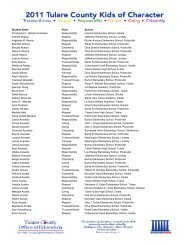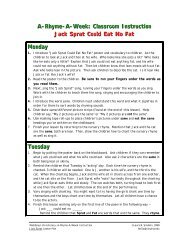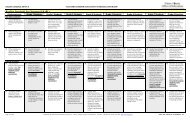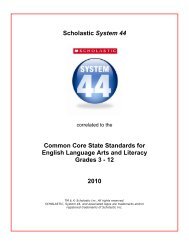Grades 9 & 10 - Tulare County Office of Education
Grades 9 & 10 - Tulare County Office of Education
Grades 9 & 10 - Tulare County Office of Education
You also want an ePaper? Increase the reach of your titles
YUMPU automatically turns print PDFs into web optimized ePapers that Google loves.
California Common Core Standards – 9 th & <strong>10</strong> th gradeProduction & Distribution <strong>of</strong> Writing4. Produce clear and coherent writing in which the development, organization, and style are appropriate to task, purpose, andaudience. (Grade-specific expectations for writing types are defined in standards 1-3 above.)5. Develop and strengthen writing as needed by planning, revising, editing, rewriting, or trying a new approach, focusing onaddressing what is most significant for a specific purpose and audience. (Editing for conventions should demonstratecommand <strong>of</strong> Language standards 1-3 up to and including grades 9-<strong>10</strong>)6. Use technology, including the Internet, to produce, publish, and update individual or shared writing products, takingadvantage <strong>of</strong> technology’s capacity to link to other information and to display information flexibly and dynamically.Research to Build & Present Knowledge7. Conduct short as well as more sustained research projects to answer a question (including a self-generated question), orsolve a problem; narrow or broaden the inquiry when appropriate; synthesize multiple sources on the subject,demonstrating understanding <strong>of</strong> the subject under investigation.8. Gather relevant information from multiple authoritative print and digital sources, using advanced searches effectively;assess the usefulness <strong>of</strong> each source in answering the research question; integrate information into the text selectively tomaintain the flow <strong>of</strong> ideas, avoiding plagiarism and following a standard format for citation including footnotes andendnotes.9. Draw evidence from literary or informational texts to support analysis, reflection, and research.a. Apply grades 9-<strong>10</strong> Reading standards to literature (e.g., “Analyze how an author draws on and transforms sourcematerial in a specific work [e.g., how Shakespeare treats a theme or topic from Ovid or the Bible or how a laterauthor draws on a play by Shakespeare]”).b. Apply grades 9-<strong>10</strong> Reading standards to literary nonfiction (e.g., “Delineate and evaluate the argument and specificclaims in a text, assessing whether the reasoning is valid and the evidence is relevant and sufficient; identify falsestatements and fallacious reasoning”).Range <strong>of</strong> Writing<strong>10</strong>. Write routinely over extended time frames (time for research, reflection, and revision) and shorter time frames (a singlesitting or a day or two) for a range <strong>of</strong> tasks, purposes, and audiences.Speaking & Listening Standards 9 & <strong>10</strong> th(SL)Comprehension & Collaboration1. Initiate and participate effectively in a range <strong>of</strong> collaborative discussions (one-on-one, in groups, and teacher-led) withdiverse partners on grades 9-<strong>10</strong> topics, texts, and issues, building on others’ ideas and expressing their own clearly andpersuasively.a. Come to discussions prepared, having read and researched material under study; explicitly draw on that preparationby referring to evidence from texts and other research on the topic or issue to stimulate a thoughtful, well-reasonedexchange <strong>of</strong> ideas.b. Work with peers to set rules for collegial discussions and decision-making (e.g., informal consensus, taking votes onkey issues, presentation <strong>of</strong> alternate views), clear goals and deadlines, and individual roles as needed.c. Propel conversations by posing and responding to questions that relate the current discussion to broader themes orlarger ideas; actively incorporate others into the discussion; and clarify, verify, or challenge ideas and conclusions.d. Respond thoughtfully to diverse perspectives, summarize points <strong>of</strong> agreement and disagreement, and, whenwarranted, qualify or justify their own views and understanding and make new connections in light <strong>of</strong> the evidenceand reasoning presented.2. Integrate multiple sources <strong>of</strong> information presented in diverse media or formats (e.g., visually, quantitatively, orally)evaluating the credibility and accuracy <strong>of</strong> each source.3. Evaluate a speaker’s or point <strong>of</strong> view, reasoning, and use <strong>of</strong> evidence and rhetoric, identifying any fallacious reasoning orexaggerated or distorted evidence.3 Formatted by <strong>Education</strong>al Resource Services, <strong>Tulare</strong> <strong>County</strong> <strong>Office</strong> <strong>of</strong> <strong>Education</strong>, Visalia, California (559) 651-3031 www.tcoe.org/ers



